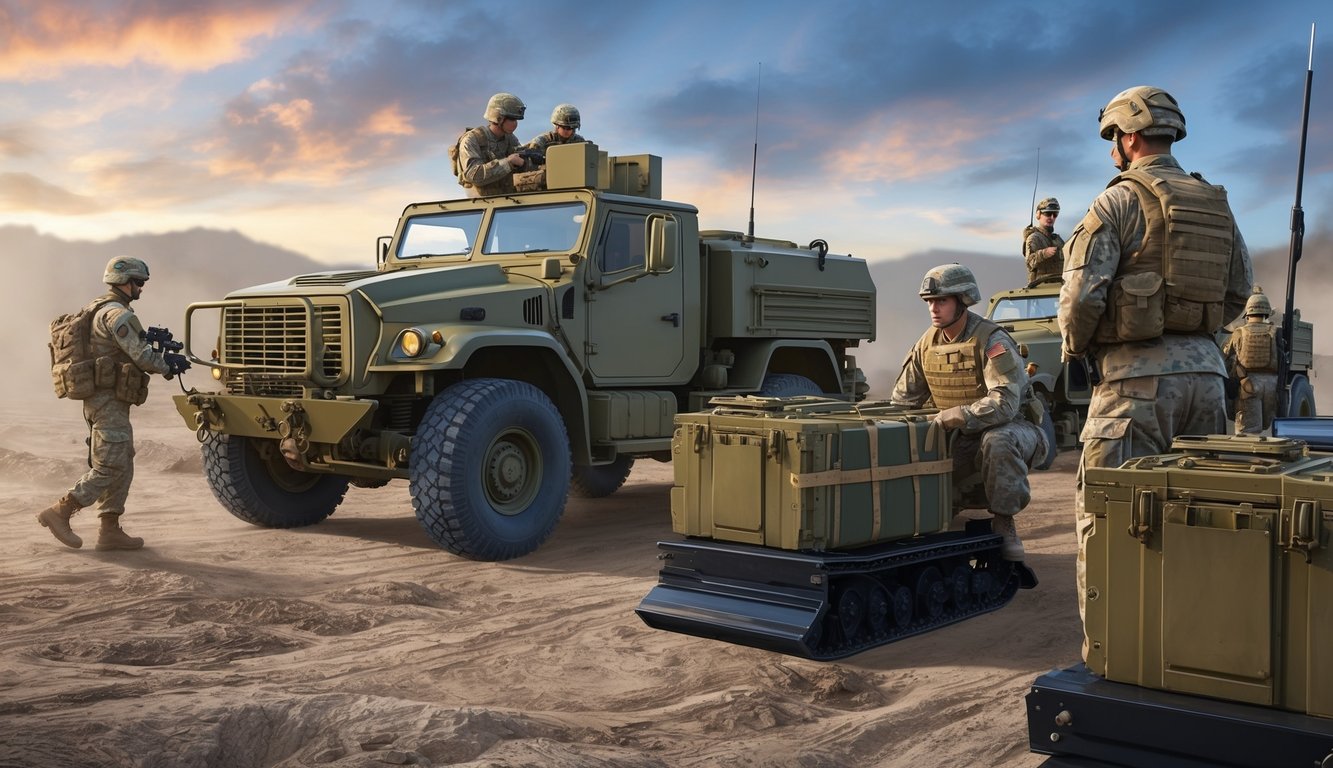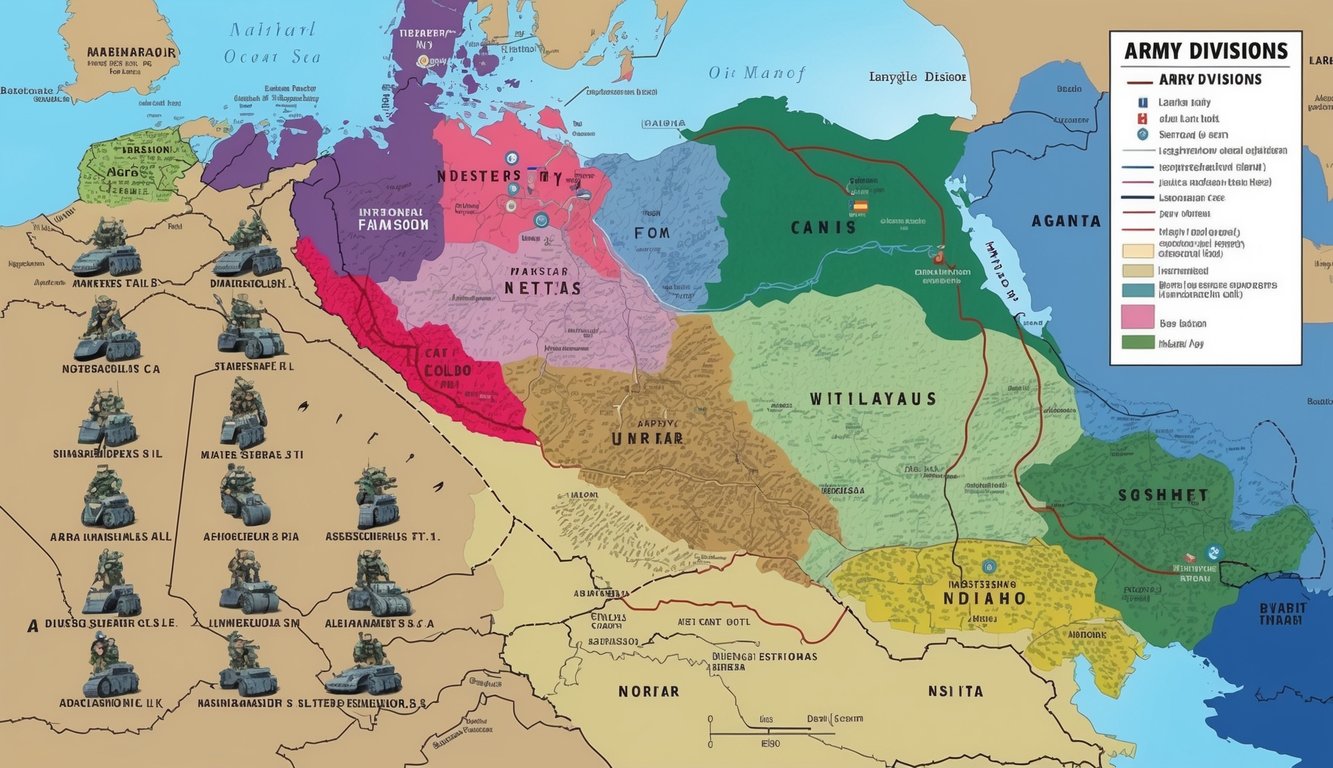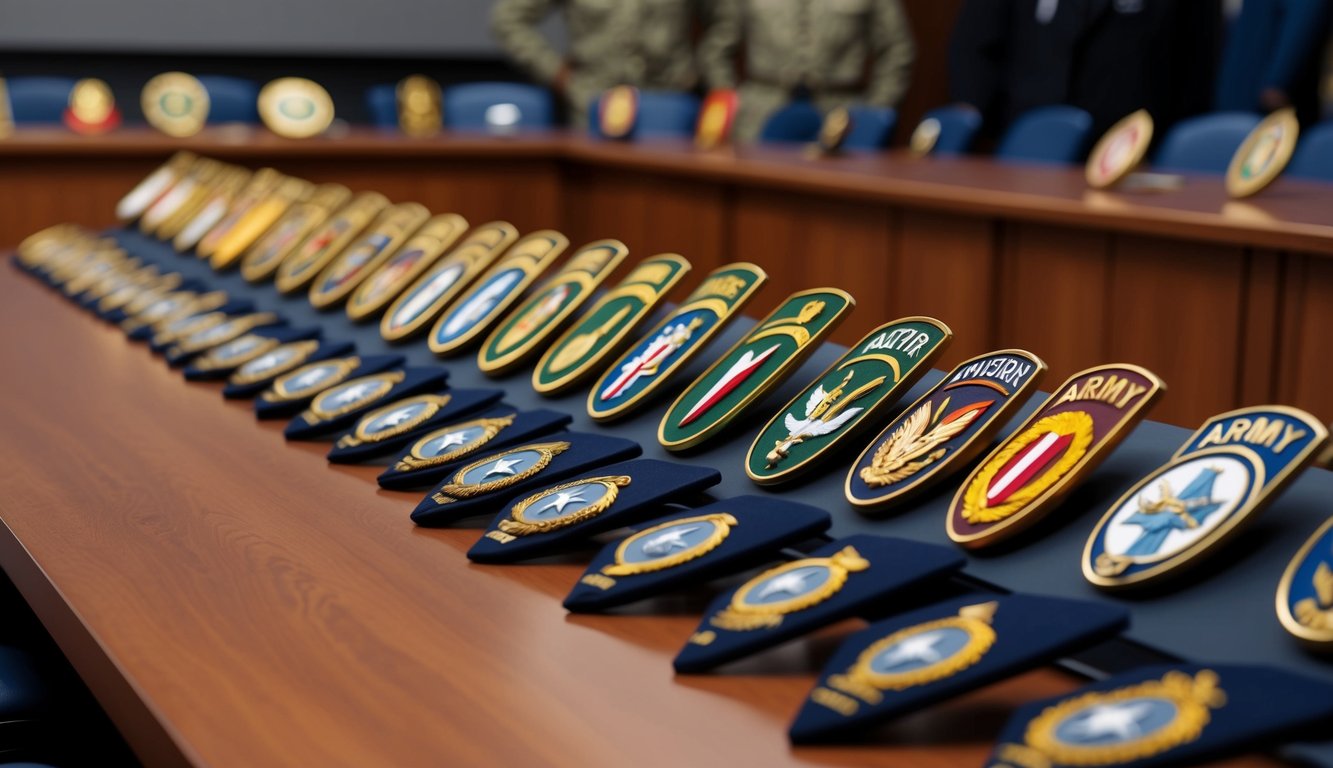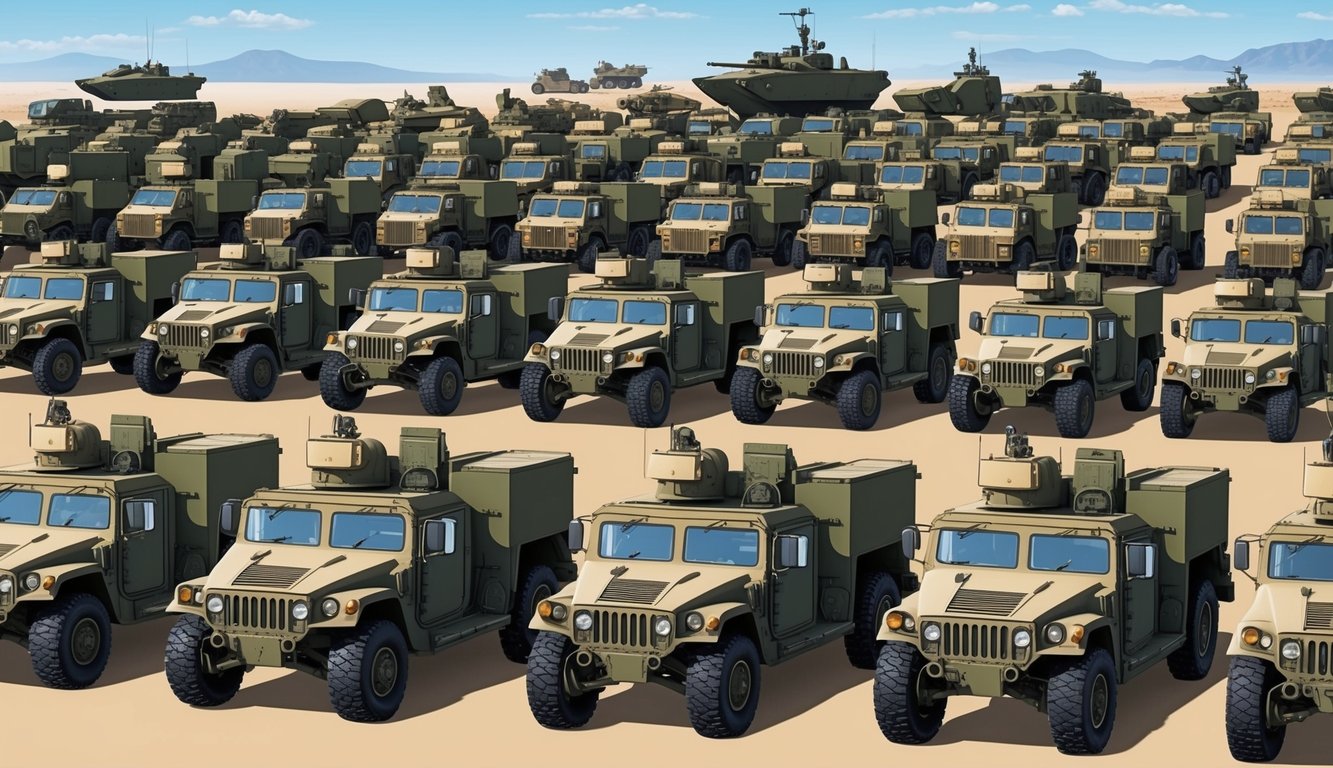Army divisions are essential to the United States Army’s combat effectiveness.
These large, flexible units function autonomously in combat, equipped for sustained operations in diverse terrains. Typically, each division comprises 10,000 to 15,000 soldiers and is structured into multiple brigades and support units.
Famous Army divisions you may know include the 1st Infantry Division, commonly referred to as “The Big Red One,” and the 101st Airborne Division, known as the “Screaming Eagles.” These divisions boast rich histories dating back to World War I and World War II, respectively.
Presently, the Army maintains a varied lineup of infantry, armored, and airborne divisions, each tailored to specific combat scenarios and missions.
Grasping the structure of Army divisions enables understanding of military organization for optimal effectiveness.
Divisions empower the Army to respond nimbly to a broad spectrum of global threats and humanitarian challenges.
Key Takeaways
- Army divisions are large, self-reliant units comprised of 10,000-15,000 soldiers.
- Divisions specialize in various combat functions, including infantry, armor, and airborne operations.
- The structure and capabilities of Army divisions are continually evolving to address modern military challenges.
Historical Overview of Army Divisions
Army divisions have been integral in shaping military history.
These sizeable units have evolved to become modern ground forces’ backbone, engaging in major conflicts and adapting to evolving warfare strategies.
Formation and Evolution
The concept of permanent divisions in the U.S. Army was established in the early 20th century.
Prior to this, divisions were temporary formations created as needed.
In 1916, Congress authorized the formation of permanent divisions, significantly altering military structure.
This initiative enabled improved training, organization, and troop deployment.
During World War I, the U.S. Army mobilized 91 divisions, comprising 68 infantry, 16 armored, 5 airborne, and 2 cavalry divisions, each with distinct combat roles ranging from frontline infantry to mobile armored units.
This diversity illustrated the Army’s capacity to adapt to various battlefield requirements.
Notable Campaigns and Battles
Army divisions have consistently led major military operations throughout history.
In World War I, divisions such as the 1st Infantry Division, or the “Big Red One,” were vital in key battles on the Western Front.
Their distinctive shoulder patch became a symbol of American bravery and resolve.
In World War II, the importance of divisions grew even more pronounced.
The 101st Airborne Division, for instance, became renowned for its valiant actions during the Normandy invasion and the Battle of the Bulge, playing a significant role in the Allied victory across Europe.
In the years following WWII, Army divisions continued to evolve, integrating advanced technologies and tactics to confront modern challenges.
Their longstanding history of service and sacrifice has profoundly impacted military tradition and national consciousness.
Types of Army Divisions
Army divisions are specialized in various forms, each designed for particular roles and combat scenarios.
These divisions constitute the operational framework of the Army, offering flexibility and adaptability in a range of military contexts.
Infantry Divisions
Infantry divisions are the backbone of the Army, positioned at the forefront of ground operations, engaging in close combat, and securing territory.
Typically, these divisions consist of multiple brigades, comprising infantry battalions and support units.
Notable active infantry divisions include the 4th Infantry Division, 7th Infantry Division, and 25th Infantry Division, well-equipped with an array of light and mechanized infantry for both mobility and firepower.
Infantry divisions exhibit versatility, enabling deployment in diverse terrains, from urban settings to rugged mountainous areas.
Their adaptability and capability to operate in challenging environments where heavier units might falter form their core strength.
Armored Divisions
For a formidable presence on the battlefield, armored divisions are indispensable.
These units focus on tank and armored vehicle operations, delivering remarkable firepower along with robust protection.
The 1st Armored Division serves as a prime illustration, comprising Armored Brigade Combat Teams with a mixture of tanks, infantry fighting vehicles, and artillery.
Armored divisions thrive in open terrains, fully utilizing their speed and firepower.
They often spearhead offensives or act as formidable mobile reserve forces, pivotal in large-scale conflicts due to their ability to exploit enemy weaknesses rapidly.
Airborne Divisions
Airborne divisions excel in rapid deployment, trained to parachute into combat zones and insert forces behind enemy lines or into hard-to-reach areas.
The 82nd Airborne Division is one of the most recognized airborne units, always on standby to deploy globally within 18 hours.
Though lightly equipped for mobility, airborne troops maintain significant striking power.
They are utilized for surprise assaults, securing strategic objectives, or swiftly reinforcing other units.
Their capacity to circumvent traditional defenses makes them invaluable in both combat and humanitarian efforts.
Structure and Organization
Army divisions possess a sophisticated organizational structure that promotes efficient command and versatile combat capabilities.
The division’s layout allows it to function as a self-contained combat unit while remaining flexible to shift based on diverse mission requirements.
Division Headquarters and Staff
At the core of every Army division is its headquarters, overseen by a Major General.
This is where the command team and supporting officers coordinate and direct operations.
The headquarters features specialized sections dedicated to personnel, intelligence, operations, and logistics.
Key staff positions typically include:
- Chief of Staff
- G1 (Personnel)
- G2 (Intelligence)
- G3 (Operations)
- G4 (Logistics)
These officers collaborate to ensure optimal division functionality, allowing for quick adaptation to changes in battlefield conditions.
Specialized Units and Support
Apart from core combat brigades, divisions integrate a variety of specialized units to enhance their operational capabilities.
These include:
- Combat aviation brigade for air support
- Artillery units for long-range fire
- Engineer battalions for mobility and counter-mobility
- Military police companies for security and law enforcement
- Reconnaissance units for intelligence gathering
- Signal companies for communications
- Medical units for healthcare and evacuation
These components provide division commanders with a comprehensive toolkit to execute diverse missions, with the specific mix adjusted to match the division’s role and operational context.
Training and Readiness

Army divisions achieve peak performance through rigorous training programs and mobilization readiness.
Units we are familiar with work on developing combat skills and rapid deployment capacities to address evolving global security challenges.
Division Training Programs
Division training programs emphasize authentic combat situations and joint operations.
Brigade Combat Teams engage in field exercises to refine tactical skills and test new equipment.
Infantry units conduct urban warfare training in mock setups, while armored and aviation components integrate their capabilities.
Your training cycle often covers:
- Individual soldier skills
- Small unit tactics
- Large-scale maneuvers
- Live-fire exercises
- Mission command systems
Division leaders evaluate unit readiness through assessments and after-action reviews, modifying training plans to address performance gaps or emerging operational needs.
Mobilization and Deployment
In terms of mobilization, divisions maintain a heightened state of readiness, conducting rapid deployment drills and keeping equipment primed for quick loading onto transport aircraft or vessels.
Key activities in mobilization include:
- Alert protocols
- Personnel accountability
- Equipment inspections
- Load planning
- Movement to ports
Regular practice of these steps ensures seamless transitions from garrison to deployed environments, facilitating swift responses to crises or urgent operations worldwide.
Units also engage in theater-specific training prior to deployments, which may involve language and cultural sensitivity training or familiarizing themselves with local geography and potential adversaries.
Modern Division Capabilities
Contemporary army divisions are equipped with advanced capabilities that merge state-of-the-art technology with enhanced operational independence, allowing for complex mission execution with increased effectiveness on modern battlefields.
Technological Advancements
Divisions now utilize cutting-edge command and control systems, enabling real-time data sharing and informed decision-making over expansive distances.
Advanced reconnaissance drones and satellite imagery enhance intelligence-gathering efforts, affording commanders a clearer understanding of the operational environment.
Furthermore, precision-guided munitions are standard, bolstering the division’s striking power while minimizing collateral damage.
Smart weapon systems integrate seamlessly with networked sensors for superior targeting capabilities.
Soldier equipment has seen substantial enhancements too; lighter yet more protective body armor, along with night vision and thermal imaging technologies, gives troops a distinct advantage in low-light scenarios.
Self-sufficient Operations
Modern divisions can function independently for extended durations.
Mobile logistics units accompany the division, ensuring supplies and maintenance capabilities are readily available.
Moreover, divisions are outfitted with their own air defense systems, providing protection against aerial threats without dependency on external assistance.
Combat engineering resources enable divisions to quickly construct or repair vital infrastructure, such as temporary bridges or clear obstacles.
Robust medical facilities, including field hospitals, can deliver advanced trauma care near the front lines.
Integrated electronic warfare capacities allow divisional forces to defend against and disrupt enemy communications, bolstering both offensive and defensive strategies.
Army Divisions by Region

Army divisions are strategically dispersed throughout various regions to maintain readiness and address differing threats.
The U.S. Army organizes its forces both within the nation and internationally, comprising a blend of active-duty and reserve elements.
United States Army Divisions
Army divisions are stationed across the nation, such as the 25th Infantry Division based in Hawaii, prepared to respond to threats in the Asia-Pacific.
Fort Drum in New York hosts the 10th Mountain Division, specializing in mountain warfare on the East Coast.
California houses the 40th Infantry Division of the National Guard, while the 1st Cavalry Division is present at Fort Hood in Texas.
The 7th Infantry Division operates out of Joint Base Lewis-McChord in Washington State, whereas Fort Bragg in North Carolina is home to the 82nd Airborne Division, known for its rapid deployment prowess.
National Guard and Army Reserve
The Army National Guard and Army Reserve are vital in regional defense.
National Guard units are present in all states, including prominent divisions like the 28th Infantry Division from Pennsylvania and the 34th Infantry Division from Minnesota.
These units can be activated for state emergencies or federal service.
Although the Army Reserve is not organized into divisions, it has units spread across the country that extend specialized support to active-duty formations.
Together, they significantly enhance the Army’s regional structure, bolstering its capacity to tackle diverse challenges across varying geographical landscapes.
The Future of Army Divisions
Big changes are on the horizon for Army divisions! The Army is initiating reforms to better prepare for future conflicts.
You can expect divisions to become more adaptable and versatile.
New division structures are anticipated, including specialized Armor, Airborne, and Air Assault divisions.
Most of the Army will be structured around two standard layouts.
This restructuring aims to enhance effectiveness in large-scale combat operations.
Divisions will again emerge as the Army’s decisive tactical unit, playing a critical role in future engagements.
Anticipate the incorporation of more cross-domain capabilities into these divisions.
Training methodologies will also evolve to become more realistic, with soldiers spending increased time in field exercises improving their skills.
This practical experience will enhance readiness for potential future conflicts.
The Army is also emphasizing stronger coordination among units, fostering enhanced communication and collaboration between different divisions and corps.
These initiatives are part of the Army’s transformation strategy, aimed at creating a more agile and capable force prepared to confront future challenges directly.
Frequently Asked Questions

Army divisions represent complex organizational frameworks featuring distinct roles and compositions.
This section addresses key inquiries surrounding divisions and the U.S. Army’s overall structure.
What’s the difference between army units and divisions?
Army units are the smaller components that form larger formations like divisions, encompassing squadrons, platoons, companies, and battalions.
Divisions are considerably larger, usually containing 10,000-15,000 soldiers organized into multiple brigades and regiments.
Can you break down the structure of the U.S. Army for me?
The U.S. Army is arranged in a hierarchical format.
At the base level are squads of 9-10 soldiers.
Three to four squads make a platoon, while a company comprises 3-5 platoons.
Battalions consist of 3-5 companies, and brigades comprise 3-5 battalions.
Divisions, commanded by major generals, generally include 3-4 brigades.
Corps consist of 2-5 divisions.
Field armies, led by lieutenant generals or generals, comprise two or more corps.
How many active divisions does the U.S. Army currently have?
As of 2024, the U.S. Army maintains 10 active-duty divisions, including infantry, armored, and airborne divisions located throughout the United States and certain overseas posts.
What were the key U.S. Army divisions involved in World War II?
Numerous U.S. Army divisions played critical roles in World War II.
Key examples include the 1st Infantry Division (The Big Red One), 82nd Airborne Division, and 101st Airborne Division.
The 3rd Infantry Division and the 4th Infantry Division were also extensively engaged in significant operations, while the 2nd Armored Division (Hell on Wheels) played a pivotal role in the European theater.
Can you name the various types of divisions found in the army?
The U.S. Army comprises several division types, each tailored for specific functions.
These include infantry divisions for traditional ground combat, armored divisions focusing on mechanized warfare with tanks and armored vehicles, airborne divisions specialized in air assault operations, air assault divisions utilizing helicopters for swift deployment, and mountain divisions trained for challenging terrain combat.
How does the U.S. Army organize its infantry divisions today?
Modern U.S. Army infantry divisions typically consist of three infantry brigade combat teams, along with a combat aviation brigade and a sustainment brigade for logistical support.
Within the division, infantry brigades are composed of infantry battalions, reconnaissance squadrons, and field artillery battalions, all supported by various combat support and service support units.

